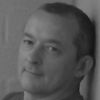On 14 January 2008, Jonny Benjamin stood on Waterloo Bridge contemplating suicide. Then a stranger stopped him, told him things would get better, and offered to take him for a coffee. That stranger saved his life.
A few years later, backed by mental health charity Rethink, Jonny launched a campaign to find his saviour. "Find Mike" went viral, and forward stepped Neil Laybourn, a personal trainer whose fiancée read about the campaign on Facebook.
Tonight that life-affirming incident is the subject of a Channel 4 documentary ("The Stranger on the Bridge," 9pm), and I'm happy for Jonny and Neil. Apparently there's Hollywood interest in a movie about that fateful moment on Waterloo Bridge and that's great too: out of utter desperation came hope. You couldn't make it up.
Except: I did.
In my first novel, "Fire Horses," published a few months after Jonny Benjamin stood on that bridge, there's a central and essential part of the book titled, "The Archway and the Angel". The book's "hero", after years of self-abuse and poverty, topped by double tragedy, stands on Suicide Bridge above the Archway Road - the A1 - and considers taking his own life:
Closing my eyes, I released my fingers and gravity was
pulling me when a hand grabbed my arm. I looked back, into
the disturbing grey eyes of an old guy, fifty or sixty, scruffy,
with a mass of curly hair, wild and as untameable as wire
wool, an erratic mess of spikes and loops. I pulled at his grip,
but not too hard. He averted his eyes and I followed his gaze
across the city; sirens called.
"They sound a bit like bells, after a time," he said quietly,
in an Irish accent. "The sirens. Do you know, it was about
here Dick Whittington heard Bow Bells. Telling him to turn
again."
He'd gone there for the same reason I had: to fall and to
fade from view. But there was someone there first - they
could hardly have jumped together, the papers would think it
was some weird pact - so he'd convinced this other bloke to
change his mind. After that, that was all he did, wait for
people like me. He told me he always knew who'd jump, and
I asked what about me. You know the answer to that one, he
said.
Although the book was published in the summer of 2008, it had been accepted in 2007; and I'd been working on versions of that central scene since 1991, as a fair number of cruel, blind agents will testify. Funnily enough, it was all those rejections (is there a worse sound, for a wannabe author, than the dull thud of a bulky Jiffy bag landing on the mat?) that gave me the idea of standing on that bridge, contemplating the city and stars.
There was no angel waiting for me: no Neil Laybourn, come to that. Or perhaps the angel was in my head. I turned again: I returned. Today I drive across that bridge every day, taking my children to school.
